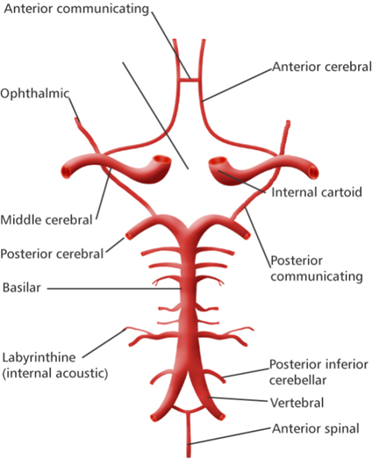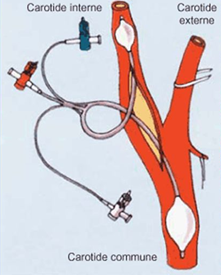Learning Modules for Common Open Vascular Procedures
Carotid Endarterectomy (CEA)
Major vessel bypass for peripheral vascular disease
Abdominal Aortic Aneurysm
Miscellaneous procedures you may encounter in the GOR
 Download the printer friendly PDF version of this page.
Download the printer friendly PDF version of this page.
Carotid Endarterectomy (CEA)
- Arterial line
- 2 IVs – preferably one devoted to infusions and one large bore
- Standard induction and emergency drugs unless otherwise indicated; err on permissive hypertension (attending preferences include MAP >90mmHg or at least 80% of baseline MAP)
- Phenylephrine infusion
- Consider remifentanil infusion for smooth extubation and tight blood pressure control
- Heparin 10,000 U
- Protamine 50mg x2
- ACT machine and cartridges
- Surgeon-specific cerebral monitoring:
- NIRS forehead monitors unless monitoring EEG/SSEP/MEP
- EEG/SSEP/MEP (by neuromonitoring team) usually for bilateral disease or severe stenosis
- Will require usual neuromonitoring anesthetic: half MAC volatile + propofol OR nitrous + remifentanil
- This is also the setup for CEAs performed by neurosurgery (i.e. Steinberg), but the idiosyncrasies of those procedures will not be covered here.
Video:
Title:
Carotid Endarterectomy |
What to expect:
- Place NIRS monitors as soon as reasonably possible after induction to collect baseline data
- Consider measuring a baseline activated clotting time (ACT). Some attendings prefer using 2x baseline ACT as a target, and if the surgeon encounters oozing at the end of the procedure despite protamine administration, a baseline ACT is useful for comparison of post-protamine ACT.
- Prior to arterial cross-clamp, you will be asked by surgeon to administer IV heparin. Make sure to verbally confirm dose and route. Usual dosage is 100 U/kg.
- After heparin administration, start a 3-minute timer. Alert surgeons when heparin has been in for 3 minutes. They will proceed with cross-clamp.
- After cross-clamp, check an ACT and communicate with surgical team. They may ask you to administer more heparin. Target is usually 200-250 seconds. (N.B. Target is >300 seconds for endovascular carotid revascularization.)
- Repeat ACT every 30 minutes and communicate to surgeons.
- Surgical manipulation of the carotid sinus baroreceptors may result in bradycardia and hypotension – see section under Procedure specific considerations.
- After the graft is sutured in, the surgeon will request protamine to reverse the heparin anticoagulation. Verbally confirm dose and timing. Protamine should be given slowly, and a 10mg (1cc) test dose is standard to detect protamine reaction. Protamine dosing is variable, the surgeon will likely ask how much heparin was given and what the most recent ACT was. Announce when all the protamine is in.
- Check a post-protamine ACT (at least 3 minutes after protamine has been administered).
- Smooth wakeup without coughing/bucking is imperative to avoid neck hematoma formation. If not using remifentanil, ensure you have adequate narcotics on board.
- Do not move patient from operating table prior to extubation. A neurologic exam is conducted to ensure patient is intact prior to moving.
Procedure-specific Considerations
Intraoperative stroke:
Most strokes in the perioperative period are embolic. During cross-clamping of the carotid artery, ischemic strokes may also occur due to hypoperfusion. Even if severe stenosis is present, cross-clamping acutely reduces flow to the ipsilateral hemisphere, whose perfusion is then entirely dependent upon collateral flow via an intact Circle of Willis. Problematically, autopsy studies found hypoplasia in 24% of specimens, and 6% had an incomplete circle due to the complete absence of a vessel. Even with an intact circle, occlusive disease in the contralateral carotid or vertebral arteries may compromise collateral blood supply. The one factor we may affect as anesthesiologists is avoiding relative hypotension compared to the patient’s baseline. Phenylephrine infusions are often used to drive the patient’s MAP to 10-20% above baseline (communicate MAP goals clearly with your surgeon), however this practice has been associated with a higher incidence of postoperative MI after CEA. Many patients presenting for CEA will have concurrent CAD. Although efforts should be made to conduct a thorough cardiac evaluation prior to surgery, excess delay should be weighed against the risk of stroke.

Antiplatelet therapy should be continued in CEA patients perioperatively, as there is strong evidence this decreases perioperative stroke. The evidence is not as strong for the continuation of these agents in other vascular procedures (see PVD module).
Shunting:
A temporary shunt may be placed to bypass the carotid cross-clamp to restore/maintain brain perfusion. Their use is extremely surgeon-specific. Communicate a significant decrease in NIRS readings (relative change by as little as 10% have been reported to have high sensitivity for ischemic symptoms) to the surgical team to aid in decision-making. Potential adverse effects of shunting include embolic stroke, arterial dissection, nerve injury (most commonly vagus and hypoglossal nerves; usually not permanent), hematoma, infection, long-term restenosis. Keep in mind that up to 65-95% of neurologic deficits during CEA are caused by embolic phenomena, which are not improved by shunting.


Cerebral monitoring:
Assess overall cerebral function:
- EEG
- SSEP
- MEP
Assess blood flow in large cerebral vessels:
- Transcranial doppler
- Carotid stump pressure
Assess cerebral metabolism:
- Near Infrared Spectroscopy (NIRS)
- Jugular venous bulb saturation
Regional technique:
Some practices employ regional anesthesia for CEA. An awake patient is the gold standard for monitoring neurologic function. Superficial cervical block has been shown to be as efficacious as deep or combined cervical block while avoiding complications of the latter, including subarachnoid injection, intravascular injection, and blockade of the phrenic, vagus, or recurrent laryngeal nerves. Currently, there is no evidence of superiority of either general or regional anesthesia for CEA.
Carotid sinus baroreceptors:
The reflexive bradycardia, hypotension, AV block or even asystole that may result from surgical manipulation of the carotid sinus typically resolves with cessation of stimulation. If the hemodynamic instability persists, atropine may be used to treat severe bradycardia. Infiltration of the carotid bifurcation with 1% lidocaine typically prevents further episodes, but infiltration itself may again trigger the carotid baroreceptor reflex, and may also promote intraoperative and postoperative hypertension by blunting the reflex even when it is appropriately triggered. Therefore routine infiltration of local anesthetic is not recommended. Of note, perioperative bradycardia and hypotension is more prevalent in endovascular carotid interventions (balloon angioplasty and stenting), and prophylactic glycopyrrolate has been employed with some success in these procedures. Routine prophylaxis with anticholinergic agents in CEA is not recommended.
Postoperative complications:
- Cerebral hyperperfusion syndrome: Chronic stenosis results in impaired cerebral autoregulation. Sudden relief of this stenosis may rarely result in ipsilateral cerebral edema, headache, seizure, focal neurologic deficit, or hemorrhagic stroke. Management: control postoperative hypertension and correct causes of increased cerebral perfusion.
- Perioperative MI: Leading cause of death after CEA. Associated with postoperative tachycardia and hypertension (hypertension is more common than hypotension after CEA). Maintain MAP within 20% of baseline.
- Respiratory complications can arise due to:
- Nerve injury: recurrent laryngeal or hypoglossal
- Neck hematoma: emergent wound exploration required if arterial (rapidly expanding)
- Altered carotid body chemoreceptor response to hypercapnia/hypoxia due to surgical manipulation. Likely to be significant only if damage is bilateral.
- Demirel S, Celi de la Torre JA, Bruijnen H, Martin E, Popp E, Böckler D, Attigah N.Effect of Superficial Cervical Plexus Block on Baroreceptor Sensitivity in Patients Undergoing Carotid Endarterectomy.J Cardiothorac Vasc Anesth. 2016 Apr;30(2):309-16.
- Goldhammer JE, Zimmerman D. Pro: Activated Clotting Time Should Be Monitored During Heparinization For Vascular Surgery. Journal of Cardiothoracic and Vascular Anesthesia 32 (2018) 1494–1496
- Jonsson M, Lindström D, Wanhainen A, Djavani Gidlund K, Gillgren P. Near Infrared Spectroscopy as a Predictor for Shunt Requirement During Carotid Endarterectomy. European Journal of Vascular and Endovascular Surgery. 2017; 53 (6):783-791.
- Kakisis JD, Antonopoulos CN, Mantas G, Moulakakis KG, Sfyroeras G, Geroulakos G. Cranial Nerve Injury After Carotid Endarterectomy: Incidence, Risk Factors, and Time Trends. Eur J Vasc Endovasc Surg. 2017 Mar;53(3):320-335.
- Valentine EA, Ochroch EA. Anesthesia for Vascular and Endovascular Surgery. In: Barash PG, ed. Clinical Anesthesia. 8th ed. Philadelphia, PA: Lippincott Williams & Wilkins, 2017.
Major vessel bypass for peripheral vascular disease
- Arterial line
- 2 IVs
- Standard induction and emergency drugs unless otherwise indicated
- Phenylephrine infusion
- Heparin 10,000 U x2
- Protamine 50mg x2
- ACT machine and cartridges
- Lead apron/screen if angiography will be performed (usually will be a request for cath lab tech in the case notes)
There are many variations on the major vessel bypass procedure, all of which involve sewing a graft onto a well perfused artery and connecting it to a poorly perfused artery distal to a point of stenosis or occlusion. Arteries that may be involved include:
Upper extremity/chest |
Lower extremity |
Abdomen |
|
|
|
In all cases, the donor artery will be cross-clamped after heparinization (typically the aorta, if involved, will be side-clamped, which results in less hemodynamic instability than a total aortic cross clamp such as in open AAA repair), the graft sewed on proximally, the distal graft attached to the recipient artery, and the cross-clamps released. Heparin and protamine administration, as well as ACT monitoring, is the responsibility of the anesthesiologist. Details can be reviewed under the What to expect section of the carotid endarterectomy procedure module.

Aortobifemoral bypass
Bypasses can be categorized as:
- Anatomic: the graft connects vessels that flow into one another (the aorta connects to the...iliacs; the iliacs connect to the...femorals 🎵)
- Extra-anatomic: the graft connects vessels that do not normally feed one another. Examples include:
- Axillofemoral bypass: the graft is first tunneled through the side body (very stimulating – keep paralyzed) then the anastamoses performed. Typically this is done for patients who are poor candidates for open belly surgery involving the abdominal aorta (e.g. previous aortic repair, major comorbidities)
- Femorofemoral bypass: the graft is tunneled to attach the ipsilateral femoral artery to the contralateral femoral artery.
Procedure-specific considerations
Coexisting conditions in vasculopathic patients:
- The majority of vascular surgery patients have some degree of CAD. See Table 40-1 from Barash below.
- 10-30% of patients with documented CAD also have PVD
- 40-60% of patients diagnosed with peripheral vascular disease (PVD) also have CAD or CVD.
- The extent of CAD correlates with the ankle-brachial index (ABI).
Table 40-1 Coronary Artery Disease (CAD) Severity for Vascular Surgery Patients Who Underwent Routine or Selective Coronary Angiographya |
||||||||||||||||||
aA significant portion of patients who underwent coronary artery angiography prior to vascular surgery were found to have advanced disease. This held true even for patients without a high clinical suspicion for significant coronary artery disease. |
Preoperative medication optimization:
- Antiplatelet agents
- Aspirin
- Recent retrospective review: aspirin withdrawal preceded >10% acute cardiovascular events
- POISE-2 trial found no difference in death, MI or stroke in those receiving aspirin; increased risk of bleeding in aspirin group. Similar results were found in the Vascular Quality Initiative in patients undergoing major vascular surgery.
- Continuation should be carefully weighed in noncarotid vascular surgery.
- Beta blocker
- POISE-1 trial: perioperative beta blockade reduced incidence of perioperative MI, but increased the risk of death or stroke.
- 2014 AHA/ACC guidelines on perioperative beta blockade:
- Continue beta blockade in patients chronically on a beta blocker
- Reasonable to begin beta blockade prior to surgery in patients who:
- Are intermediate or high risk for MI based on preop testing
- Have >3 cardiac risk factors
- Do not start beta blockers on day of surgery
- A recent Cochrane review have found no benefit in perioperative beta blockade over placebo in patients undergoing vascular surgery, but found greater incidence of perioperative hypotension and bradycardia
- ACE inhibitor/ARB
- AHA/ACC guidelines: reasonable to continue perioperatively, or if held, to restart as soon as clinically feasible
- However many hold these agents due to risk for refractory vasoplegia intraoperatively
- Statins
- AHA/ACC: Recommended to continue, reasonable to start in patients undergoing vascular surgery
- Meta-analysis data for statins specific to vascular surgery population showed mixed results, less robust benefit than for the general population
Vasculopathy and arterial/venous access:
Many patients with PVD will have calcified/diseased vessels making arterial and venous access more difficult. Plan extra time for line placement both preoperatively and intraoperatively. Have a low threshold to call for an ultrasound.
- Hertzer NR, Beven EG, Young JR, et al. Coronary artery disease in peripheral vascular patients: a classification of 1000 coronary angiograms and results of surgical management. Ann Surg. 1984;199:223-233.
- Valentine EA, Ochroch EA. Anesthesia for Vascular and Endovascular Surgery. In: Barash PG, ed. Clinical Anesthesia. 8th ed. Philadelphia, PA: Lippincott Williams & Wilkins, 2017.
- Young J, Patel SK. Peripheral Vascular Bypass. [Updated 2018 Oct 27]. In: StatPearls [Internet]. Treasure Island (FL): StatPearls Publishing; 2018 Jan-. Available from: https://www.ncbi.nlm.nih.gov/books/NBK499827/
Abdominal Aortic Aneurysm
- Arterial line
- Central line
- Thoracic epidural (may or may not run intraoperatively depending on attending preference)
- TEE (some will not use)
- 2 IVs, at least one large bore
- Level 1
- Standard induction and emergency drugs unless otherwise indicated (plus vasopressin and bolus syringes of your “downer” infusions)
- Phenylephrine infusion, consider having epinephrine infusion in the room
- Esmolol infusion
- Nitroglycerin infusion or clevidipine – attending preference. Nitroglycerin has added benefit of dilating coronaries in patients with CAD, plus will venodilate to “make room” for the increase in preload with cross-clamp). Clevidipine is a predictable arterial dilator for afterload reduction.
- Mannitol if suprarenal (some use for renal protection)
- Calcium chloride x2
- Sodium bicarbonate x2
- Insulin and D50 (for hyperkalemia with reperfusion)
- Heparin 10,000 U x2
- Protamine 50mg x2
- ACT machine and cartridges
Resources on surgical approach:
Abdominal Aortic Aneurysm Open Repair
Open surgical repair of abdominal aortic aneurysm
Open vs endovascular repair of AAA
- Multiple RCTs: UK EVAR 1, DREAM, USA OVER, ACE
- EVAR = better short-term mortality, decreased LOS, higher rate of reintervention (to address endoleaks)
- No difference in long term mortality
- EVAR can be done under GA, neuraxial, MAC + local
- NSQIP database 2005-2008: GA = increased pulmonary morbidity and LOS, but no difference in mortality
- Patients who get open AAA repairs tend to be one of the following
- Younger (more time for endoleaks to develop, more interventions = more risk)
- Live in remote locations (limited access to reinterventions)
- Have unfavorable aneurysm anatomy (too large, short or angulated aneurysm neck morphology, renal artery anomalies)
- Have concurrent aortoiliac occlusive disease or iliac aneurysms
Procedure-specific considerations
Aortic cross-clamping (AoX):
Will cause significant swings in hemodynamics during both application and removal. Must understand physiology and how to prepare/react to these changes.
- Pre-clamping
- Mannitol for renal protection (if using)
- Restrict fluids (preload increases with AoX)
- Start your vasodilator infusion as tolerated to prepare for increased preload and increased afterload with AoX
- Give heparin when surgeon requests. Confirm dose, typically 100 U/kg. Start timer, tell surgeons when it’s been 3 min.
- Mark time when AoX applied – important you record ischemia times for ICU report
- Clamp application
- Afterload increases
- Uptitrate esmolol and vasodilator as needed
- Preload increases (but rarely can decrease if infraceliac clamp with low splanchnic venous tone – see figure)
- Once clamp has been applied, can cautiously begin giving albumin to prepare for sudden drop in afterload/preload with sequential unclamping
- Cardiac output typically decreases
- Despite blood pressure looking fine!
- Heart rate usually unchanged

- Sequential unclamping: For each unclamping, clearly communicate with surgeons to time your preparation for reperfusion effects. Check frequent ABGs, correct hypocalcemia, hyperkalemia, acidemia (this is what your calcium chloride, insulin/D50, and bicarb are for). Have pressors ready to treat hypotension with cross-clamp release. This is similar to the steps in liver transplant reperfusion, though often not as dramatic since ischemia times are shorter.
- Renal ischemia (if starting suprarenal)
- Time until AoX moved to infrarenal
- R leg ischemia time
- Will reperfuse one leg first, then work on anastomosis of other leg
- L leg ischemia time
- Usually the worst of the negative reperfusion effects
- Post-unclamping:
- Bolus epidural if stable
- MAP goals typically 70-90mmHg
- Extubate (unless complications/concerns)
- Transport to ICU
- Gelman, S. The Pathophysiology of Aortic Cross-clamping and Unclamping. Anesthes 1995;82(4):1026-1057.
- Greenhalgh, R. M. et al. Endovascular versus open repair of abdominal aortic aneurysm. The New England journal of medicine 362, 1863–1871, doi:10.1056/NEJMoa0909305 (2010).
Miscellaneous procedures you may encounter in the GOR
AV fistula: Single shot regional block unless otherwise indicated. Communicate with surgeons about location of fistula placement/revision, as this will determine whether the block will cover the surgical site. Rarely a general must be performed, in which case take the time to set up for a complex vasculopathic ESRD patient. LMA acceptable unless symptomatic GERD or obese. Do not need to monitor ACT but will still give IV heparin/protamine (surgical times are short and predicable). Of note, these do not count toward ACGME case requirements.
Limb amputation: Regional block or spinal unless otherwise indicated. Sometimes for very distal digits the surgeons will inject local. Often patients are already quite insensate given pathophysiology of why they are losing the limb.
Rib resection: Often healthy patients with thoracic outlet syndrome. Standard GA, no need for invasive monitoring.
Venous ablation: Often healthy patients, LMA and standard GA. Done under local/MAC at other institutions but surgeons prefer GA here.



